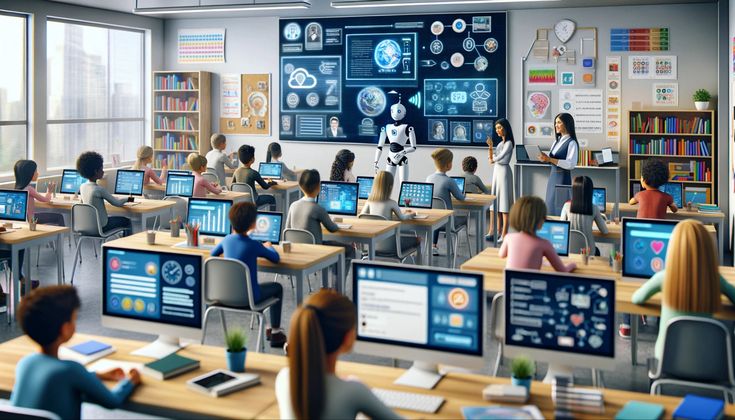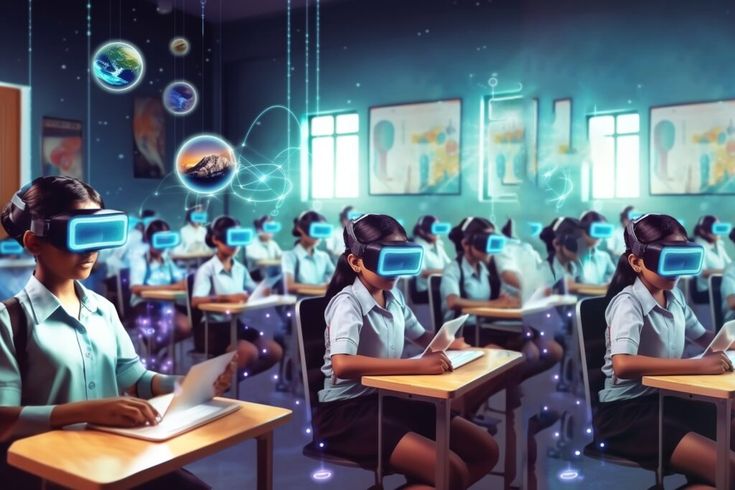Table of Contents
Introduction:

1. Personalized Learning Paths
AI in education is enabling personalized learning experiences by analyzing students’ strengths, weaknesses, and preferences. Unlike traditional learning environments, where all students are taught the same way, AI-powered platforms can offer tailored educational content based on individual needs, helping students learn at their own pace.
Example:
DreamBox, an AI-based platform, adapts math lessons to each student’s learning style, analyzing performance data to provide customized exercises. This leads to improved retention and better understanding, as students receive lessons designed specifically for their skill level.
2. Automated Administrative Tasks
AI is transforming education by reducing the burden of repetitive tasks like grading, scheduling, and attendance tracking. By automating these tasks, teachers can focus on providing quality instruction and engaging with students, rather than managing administrative duties.
Case Study:
At Georgia Tech, AI-based teaching assistant “Jill Watson” responded to student questions and managed administrative queries in an online course. This freed up educators’ time, allowing them to concentrate on more complex teaching tasks and improving the overall student experience.
3. Virtual Classrooms and Remote Learning
AI in education is powering virtual classrooms that create a more interactive and accessible learning environment for students, regardless of geographic location. With AI tools, students can participate in virtual discussions, access course materials, and even receive real-time feedback from teachers.
Example:
Google Classroom uses AI to help teachers manage assignments, track student progress, and offer feedback. During the COVID-19 pandemic, such tools proved invaluable in keeping students connected with their teachers and ensuring uninterrupted learning.
4. AI-Driven Content Creation
AI is changing education by enabling the creation of smart content, such as AI-generated study guides, quizzes, and exercises. These tools adjust content based on student performance, ensuring that students receive material that suits their level of understanding.
Example:
Knewton, an adaptive learning platform, provides AI-powered content tailored to individual learning paths. It helps students by delivering customized learning materials and identifying areas where they need further practice.

5. Smart Tutoring Systems
AI in education is driving the development of AI-based tutoring systems that offer round-the-clock assistance to students, providing them with immediate help when they need it. These virtual tutors, powered by AI in education, help explain difficult concepts and guide students through problem-solving processes, complementing in-classroom learning.
Example:
AI-driven platforms like Squirrel AI in China offer smart tutoring systems that continuously adapt to each student’s learning pace. These systems help students improve their performance by offering real-time feedback and practice exercises based on their current level.
6. Improved Student Engagement with Gamification
AI has revolutionized digital learning by introducing gamification, where lessons are turned into engaging, game-like experiences. By using AI to assess student progress and adjust difficulty levels, these platforms keep students motivated to learn and improve.
Example:
Kahoot!, an AI-powered gamified learning platform, engages students with interactive quizzes and challenges that make learning fun. The AI analyzes quiz results and provides insights into students’ performance, helping teachers adjust lesson plans.
7. Language Translation and Cross-Cultural Learning
AI-powered language translation tools allow students from different linguistic backgrounds to access the same educational materials. This opens doors for non-native speakers to enroll in courses offered in other languages, thus increasing educational inclusivity.
Example:
Duolingo uses AI to offer personalized language learning experiences. The platform’s AI adapts its lessons based on user performance, allowing learners to progress at their own pace while receiving content in various languages.

8. Real-Time Data Analytics for Student Progress
AI provides real-time insights into student performance, allowing teachers to make data-driven decisions. AI-driven analytics track students’ learning habits and flag issues before they escalate, helping educators to intervene in a timely manner.
Case Study:
The University of Southern California implemented AI-powered analytics in its online courses to track student progress. The AI identified students who were falling behind and allowed instructors to offer targeted support, improving overall success rates.
9. Adaptive Testing and Assessment
Traditional testing methods often fail to cater to the diverse learning needs of students. AI-powered adaptive testing adjusts the difficulty of questions based on the student’s previous answers, ensuring that assessments are more reflective of the student’s capabilities.
Example:
Platforms like Pearson’s AI-powered adaptive assessments use machine learning algorithms to personalize exam questions based on individual performance. This allows teachers to get a better understanding of each student’s strengths and weaknesses.
10. Preparing Students for a Digital Future
AI in education not only enhances current learning experiences but also prepares students for a future where AI and technology will play a significant role in various industries. Digital literacy is becoming an essential skill, and AI tools help students gain hands-on experience with cutting-edge technologies.
Example:
AI-based platforms like IBM’s Watson Education help students develop problem-solving and critical thinking skills while learning how to work with AI tools. These skills will be crucial in industries like healthcare, finance, and technology.

Case Study: AI in Virtual Classrooms – Georgia Tech
One of the most notable examples of AI in education is Georgia Tech’s use of “Jill Watson,” an AI-powered teaching assistant, in its online master’s program. Jill answered routine student questions related to assignments, deadlines, and course materials. Students were unaware that they were interacting with AI, as Jill provided quick and accurate responses to a large volume of inquiries. This case study highlights how AI can streamline administrative tasks, allowing educators to focus on high-quality teaching.
Conclusion:
The integration of AI in education and digital technologies is reshaping the learning experience for both students and teachers. From personalized learning paths and virtual classrooms to real-time analytics and smart tutoring, AI in education is driving a digital transformation in education. These technologies not only enhance current learning environments but also prepare students for a future where digital literacy and AI in education proficiency are essential. As AI continues to evolve, its role in education will become even more significant, making it a cornerstone of modern learning systems.